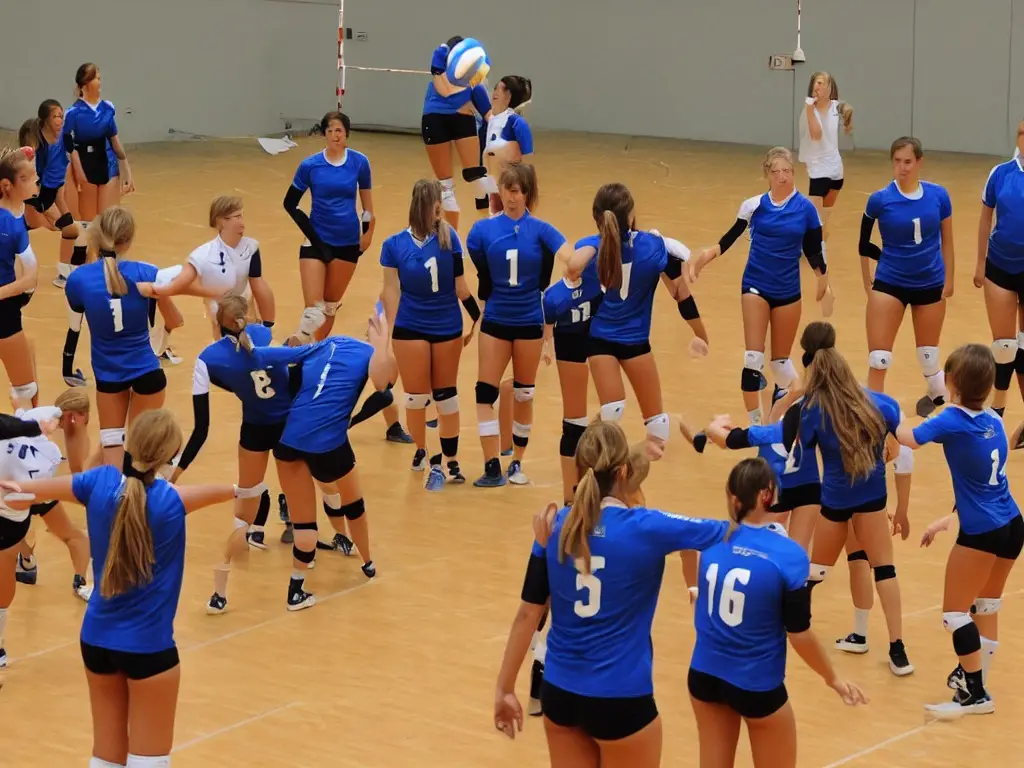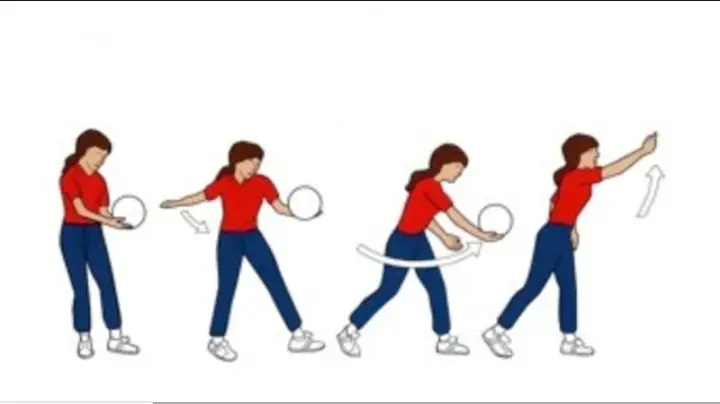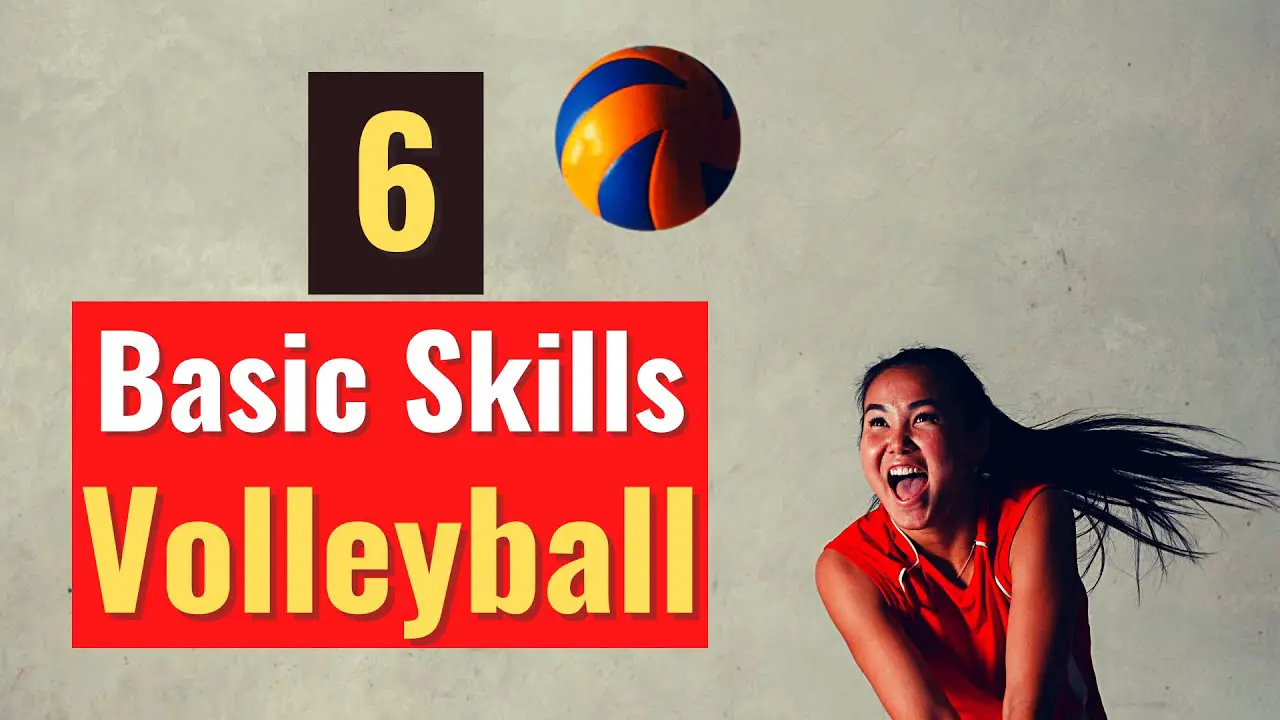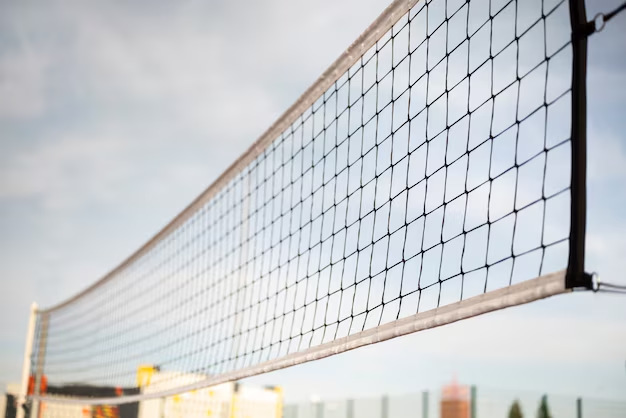Hello friends! In today’s article, we are going to talk about the six basic skills in volleyball. Whether you’re a pro or new to volleyball, this article will help you know the basic skills and fundamentals of the game.
So stay tuned!
Before we begin, make sure you read to the end, comment, and share.
What are the basic skills in volleyball?

The basic skills in volleyball are:
- Serving
- Passing
- Setting
- Attacking
- Blocking
- Digging.
These skills are the basics and the foundation of the game, and are essential for both offensive and defensive play. Mastering these skills is crucial for success on the volleyball court. Let us look at each of them in detail.
1. Serving: Basic Skills in Volleyball
What is serving in volleyball? The serve or service is the action that puts the ball in play. A well-performed serve is one that makes it difficult for the opposing team to receive (pass).
The serve initiates each rally and offers a prime opportunity to seize control. Accuracy and consistency are key to executing successful serves, which can disrupt opponents and set the stage for offensive plays. Let’s look at the types of serves in volleyball.
Types of serve in volleyball
In volleyball, there are many types of serves, each with its own characteristics and purposes. Here are some common types of serves:
- Underhand Serve: This is a basic serve where the player strikes the ball with their fist or open hand below waist level. It’s good for beginners due to its simplicity and reliability.

- Overhand Serve: Also known as the overhead serve, this serve involves striking the ball with an open hand above the head. It allows for more power and accuracy compared to the underhand serve and is commonly used by intermediate- to advanced-level players.
- Jump Serve: The jump serve is a powerful and dynamic serve where the player jumps into the air before striking the ball. It adds extra velocity to the serve and can be challenging for opponents to receive.
- Float Serve: A float serve is characterized by minimal spin, causing the ball to move unpredictably in the air. It creates difficulties for the receiving team in accurately predicting the ball’s trajectory.
- Topspin Serve: This serve involves imparting topspin on the ball, causing it to dip sharply as it approaches the opponent’s court. It can be effective in putting pressure on the receiving team and limiting their options.
- Jump Float Serve: A combination of the jump serve and float serve, this serve combines power with the unpredictability of a float serve. It requires precise timing and technique but can be a potent weapon when executed effectively.
Every type of serve offers its own advantages and challenges, and players often develop their preferred serving style based on their skill level and playing style.
Read also: Substitution in volleyball: Here is what you should know
2. Passing: Basic Skills in Volleyball
What is passing or reception in volleyball?Passing (reception), or pass, in volleyball is the action of receiving the opponent’s serve and passing the ball to the team’s setter.
Passing, also known as bumping, also involves receiving the ball from the opponent’s serve or hit. It sets the foundation for offensive plays by keeping the ball in play and facilitating setting. Proper passing skills involved getting in the right position, keeping arms straight, and making contact with the ball using forearms.
The most commonly used skill for the reception or pass in volleyball is the bump.It’s important to note that the ball should be hit by the forearms during the execution of the bump.
Read more about volleyball passes and their types.
3. Setting: Basic Skills in Volleyball
Setting in volleyball is a basic skill that plays a crucial role in facilitating offensive plays. Here’s an overview of setting in volleyball:
What is Setting skills in volleyball?
Definition: Setting, also known as overhead passing, is one of the basic skills in volleyball. It is the act of directing the ball to a teammate for them to attack (spike) it over the net.
The set is usually the second of the three allowed hits that each team has.
It is typically performed by the team’s setter, although other players may also set the ball when necessary.
Technique:
- Hand Position: The setter forms a triangular shape with their thumbs and index fingers, creating a platform for the ball to contact. The hands should be positioned above the forehead, with fingers spread comfortably.
- Footwork: Setters use footwork to position themselves under the ball and generate power for the set. This often involves taking small steps to adjust to the ball’s trajectory.
- Timing: Timing is crucial in setting, as setters must anticipate the ball’s trajectory and make split-second decisions about where to direct the set.
- Contact: The ball should be contacted with the fingertips, allowing for precision and control. Setters use their wrists and arms to guide the ball to the intended target.
- Follow-through: After making contact with the ball, setters follow through with their arms and bodies to ensure accuracy and consistency in the set.
Purpose:
- The goal of the set is to put the ball next to the nets so that a fellow player may execute an attack.
- Setting sets up the offensive play by directing the ball to a teammate in a position to attack.
- It allows hitters to approach the ball and execute a spike with power and precision.
- An effective setting enables teams to vary their offensive strategies and keep the opposing defense guessing.
Variations:
- Quick Set: A quick set is a fast-paced set delivered close to the net, allowing the hitter to attack before the opposing blockers are fully set up.
- High Set: A high set is delivered with more height, giving the hitter time to approach and jump before executing a spike.
- Back Set: In a back set, the ball is set behind the setter, creating opportunities for hitters to attack from different angles.
- Dump Set: Sometimes, setters will surprise the opposing team by quickly tipping the ball over the net instead of setting it for a spike. This is known as a dump set.
Training: Setter-specific drills focus on footwork, hand positioning, and decision-making.
Repetition and practice are key to developing consistency and accuracy in setting.
Setters often work closely with hitters to develop chemistry and timing in their connections.
The setting technique most commonly used in the set or volley.
4. Attacking: Basic Skills in Volleyball
Attacking in volleyball, also known as spiking or hitting, is a basic offensive skill that aims to score points by forcefully driving the ball into the opponent’s court. Here’s an overview of attacking in volleyball:
Definition: Attacking involves a player (the hitter) jumping and striking the ball with force and precision to send it over the net and into the opponent’s court. It is the final step in the pass-set-spike sequence that forms the foundation of offensive play in volleyball.
Technique:
Approach: Hitters typically use a three-step approach to generate momentum and power before jumping to attack the ball. The approach involves steps in a specific order, often left-right-left for right-handed hitters and right-left-right for left-handed hitters.
Jump: Timing and coordination are crucial in the jump phase of the attack. Hitters jump explosively off both feet, reaching maximum height to execute the spike.
Arm Swing: The arm swing is the motion used to strike the ball. It involves a sequence of movements, including the reach-back, upward swing, and follow-through, to generate power and control.
Contact: The hitter makes contact with the ball at the peak of their jump, ideally at the highest point possible. The contact point varies depending on the type of attack and the hitter’s position on the court.
Placement: Hitters aim to place the ball strategically on the opponent’s court, targeting areas with fewer defenders or exploiting weaknesses in the defense.Types of attacks:
Spiking: The most common type of attack, spiking involves hitting the ball forcefully downward into the opponent’s court with the palm of the hand.
Tip or Roll Shot: A finesse shot where the hitter uses the fingertips to lightly tap the ball over the net, often to avoid blockers or exploit open spaces in the defense.
Off-Speed Shot: A variation of the spike where the hitter reduces the speed of the attack, aiming to catch the defense off-guard with a slower-paced ball.
Tool or tooling: intentionally hitting the ball off the opponent’s blockers’ hands to deflect it out of bounds, creating a point for the attacking team.
Training: Attacking drills focus on developing the approach, arm swing, and timing necessary for effective spiking.
Hitters work on variations of attacks, including cross-court spikes, line spikes, and off-speed shots, to expand their offensive arsenal.
Coordination and communication between setters and hitters are essential for executing successful attacks, emphasizing teamwork and chemistry on the court.
Attacking in volleyball is a basic and essential skill that requires athleticism, timing, and technique.
A strong attacking game can put pressure on the opposing team’s defense and contribute significantly to a team’s success in scoring points and winning matches.
5. Blocking: Basic Skills in Volleyball
Blocking in volleyball is a basic defensive skill used to stop the opposing team’s attack and potentially score points.
Here’s an overview of blocking in volleyball:
Definition: Blocking is the action of deflecting or intercepting the ball at the net as it crosses from the opponent’s side to the defender’s side. It involves jumping near the net and extending the arms to create a barrier that redirects or stops the ball.
Technique:
- Positioning: Blockers position themselves near the net, anticipating the opponent’s attack and preparing to jump to block the ball. They aim to close the gap between themselves and the net to minimize the attacker’s angle.
- Timing: Timing is crucial in blocking, as blockers must jump at the right moment to intercept the ball as it crosses the net. Effective timing allows blockers to reach the highest point of their jump and make contact with the ball at its peak.
- Hand Position: Blockers extend their arms upward and forward, creating a wall-like barrier to deflect or block the ball. The hands are angled to direct the ball back into the opponent’s court or to the defender’s teammates.
- Footwork: Blockers use footwork to position themselves laterally along the net, adjusting their stance to align with the attacker’s approach and angle of attack.
- Pressing: After making contact with the ball, blockers press their hands over the net, exerting downward pressure to control the direction of the block and prevent the ball from crossing into their court
Types of blocks in volleyball:
- Solo Block: A block performed by a single player without assistance from teammates. Solo blocks are effective when the blocker successfully anticipates the attacker’s angle and timing.
- Double Block: A block performed by two players working together to form a larger and more effective barrier at the net. Double blocks are coordinated between teammates to cover more space and limit the attacker’s options.
- Soft Block: A block executed with less force, aimed at deflecting the ball rather than stopping it outright. Soft blocks are used to slow down the attack and create opportunities for defenders to control the ball.
Training: Blocking drills focus on developing timing, footwork, and hand positioning for effective blocking.
Blockers practice reading the opponent’s attacks and anticipating the direction and speed of the ball.
Coordination and communication between blockers and defenders are essential for successful blocking and defensive play.
See Also:
- 4 Best Position in Volleyball
- Volleyball Positions Diagram: Roles and Responsibilities (2024 updated)
- What is MB in volleyball? Volleyball position terms explained
- 7 Volleyball Conditioning Drills: A Comprehensive Guide for Players
- Volleyball Positions Explained: A Comprehensive Guide for Players
6. Digging: Basic Skills in Volleyball
Digging in volleyball is a basic defensive skill used to prevent the ball from hitting the ground after an opponent’s attack. Here’s an overview of digging in volleyball:
Definition: Digging is the act of retrieving the ball from the air or off the ground to keep it in play and set up an offensive play for one’s team. It typically involves players diving or lunging to reach the ball and making controlled contact to direct it to a teammate.
Technique:
- Positioning: Players anticipate the opponent’s attack and position themselves in the backcourt to defend against various types of shots. They maintain a low stance with their knees bent and their weight balanced on the balls of their feet to react quickly to the ball’s trajectory.
- Movement: Players move laterally and diagonally to track the ball’s path and position themselves to make a play. They use quick footwork to adjust their position and angle of approach to the ball.
- Platform: Digging involves using the forearms to create a platform for contacting the ball. Players extend their arms forward and together, forming a flat surface with their forearms to absorb the impact of the ball and control its direction.
- Absorption: Players absorb the force of the incoming ball by allowing it to make contact with their forearms while maintaining a firm and stable platform. They angle their arms to control the trajectory of the ball and direct it to the intended target.
- Recovery: After making a dig, players quickly transition to a ready position to prepare for the next play. They focus on maintaining defensive readiness and positioning to react to subsequent attacks.
Types of digs:
- Underhand Dig: A dig executed with the arms held close together and the hands positioned below the ball. Underhand digs are used for low, fast-paced shots that are difficult to reach with the hands.
- Overhand Dig: A dig performed with the arms extended overhead and the hands positioned above the ball. Overhand digs are used for higher shots that require reaching above the head to retrieve.
- Roll or Pancake Dig: A defensive maneuver where the player extends one arm flat on the ground and slides it under the ball to lift it up and keep it in play. Roll digs are used for balls that are close to the ground and difficult to reach with the forearms
Training:
Digging drills focus on improving reaction time, footwork, and platform control for effective defensive play.Players practice reading the opponent’s attacks and anticipating the direction and speed of the ball. The emphasis is placed on communication and teamwork to ensure seamless defensive coverage and transition to offensive play.
Conclusion
Congrats for reading it to the end!
Knowing the basic skills in volleyball is essential for success on the court. Basic skills in volleyball are serving, passing, setting, attacking, blocking, and digging. These skills form the foundation of the game, enabling players to execute offensive and defensive strategies effectively.
Each skill requires precision, timing, and coordination, and players must dedicate themselves to continuous practice and improvement.
By practicing these basic skills in volleyball, players can enjoy their game’s performance, contribute to their team’s success, and experience the excitement and satisfaction of competing in one of the world’s most dynamic team sports.
Whether you’re a beginner learning the skills or an experienced player refining your technique, focusing on these basic skills lays the groundwork for achieving success and enjoyment in volleyball.




